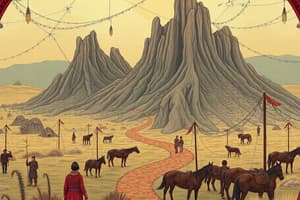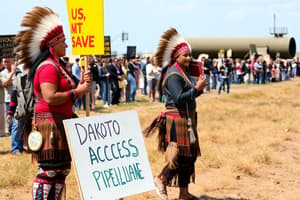Podcast
Questions and Answers
What did Energy Transfer sue the tribe for?
What did Energy Transfer sue the tribe for?
Blocking construction.
What is the core principle that the Standing Rock movement adopted?
What is the core principle that the Standing Rock movement adopted?
Protectors, not protesters.
What act did the Youth Council donate items for the police officers near the barricade as?
What act did the Youth Council donate items for the police officers near the barricade as?
An act of prayer and care.
What is the intended purpose of the Dakota Access Pipeline?
What is the intended purpose of the Dakota Access Pipeline?
What was the purpose of the Forgiveness March?
What was the purpose of the Forgiveness March?
What was the phrase said to stand for what is right?
What was the phrase said to stand for what is right?
What initial action did the International Indigenous Youth Council (IIYC) take to protest the Dakota Access Pipeline?
What initial action did the International Indigenous Youth Council (IIYC) take to protest the Dakota Access Pipeline?
What did the Fort Laramie Treaty of 1851 grant to the Sioux?
What did the Fort Laramie Treaty of 1851 grant to the Sioux?
What reasons did the Standing Rock Sioux give for opposing the Dakota Access Pipeline?
What reasons did the Standing Rock Sioux give for opposing the Dakota Access Pipeline?
According to Energy Transfer Partners, how does transporting oil via pipeline compare to truck or rail?
According to Energy Transfer Partners, how does transporting oil via pipeline compare to truck or rail?
Flashcards
Dakota Access Pipeline (DAPL)
Dakota Access Pipeline (DAPL)
A $3.7 billion project to transport crude oil from North Dakota to southern Illinois.
Standing Rock Sioux
Standing Rock Sioux
The tribe that led the protest against the Dakota Access Pipeline due to concerns about water contamination and sacred sites.
International Indigenous Youth Council (IIYC)
International Indigenous Youth Council (IIYC)
An organization of young indigenous people dedicated to advocacy and protection of indigenous rights.
Fort Laramie Treaty of 1851
Fort Laramie Treaty of 1851
Signup and view all the flashcards
Water Protectors/Land Protectors
Water Protectors/Land Protectors
Signup and view all the flashcards
"Protectors, not protesters"
"Protectors, not protesters"
Signup and view all the flashcards
"Today is a good day to die"
"Today is a good day to die"
Signup and view all the flashcards
Oceti Sakowin Camps
Oceti Sakowin Camps
Signup and view all the flashcards
Forgiveness March
Forgiveness March
Signup and view all the flashcards
Prayer March
Prayer March
Signup and view all the flashcards
Study Notes
Standing Rock Protests and Dakota Access Pipeline
- The Standing Rock Sioux, along with allies, camped for months on the Cannonball River banks in North Dakota.
- Their objective was to stop the Dakota Access Pipeline, a $3.7 billion project.
- The pipeline is designed to transport crude oil from North Dakota to southern Illinois.
- The proposed pipeline route runs within 1,500 feet of the Standing Rock Reservation.
- The tribe is concerned about the pipeline contaminating their drinking water and desecrating sacred sites.
- The International Indigenous Youth Council (IIYC) spearheaded the global support for this cause.
- The youth council believes they will make the final stand to stop the pipeline.
- The movement started with the no DAPL runners who ran to DC and Omaha.
- The youth council began with five people and expanded to a core of around 20 members, with meetings attracting 30-50 people.
- The youth council has stated that historically, indigenous children were forcibly removed from their families, and their culture was suppressed.
- Youth council members are inspired by land and water protectors.
Historical Context and Treaty Rights
- Understanding the conflict requires considering centuries of history.
- The Standing Rock Sioux ancestors originally lived in the Great Lakes region.
- They migrated west by the 17th century due to white fur traders and resource competition.
- The discovery of gold in 1848 brought white settlers across Sioux territory, leading to conflict.
- The Fort Laramie Treaty of 1851 granted the Sioux lands from North Dakota to Nebraska.
- The treaty was a peace contract that was broken as westerners encroached.
- Subsequent treaties and congressional acts further reduced Sue lands.
- By the late 19th century, the Sioux faced assimilation schools, religious bans, and the Wounded Knee Massacre.
Pipeline Company and Tribal Opposition
- Energy Transfer Partners claims the pipeline is safer than transport via truck or rail.
- The company asserts the pipeline poses no threat to water or sacred sites.
- The CEO wished the Standing Rock Sioux had engaged in earlier discussions to change the route.
- The Standing Rock Sioux expressed opposition to the Dakota Access Pipeline in 2014, citing treaty boundaries from 1851 and 1868.
- The tribe opposed any pipeline within that treaty boundary.
- The Standing Rock Sioux maintain a position to protect water, sacred places, and sovereignty.
- The Army Corps of Engineers issued an environmental assessment despite appeals from federal agencies, and pipeline construction commenced without the Tribe's consent.
- The tribe then sued the Army Corps.
- Energy Transfer sued the tribe for blocking construction.
- Protests and camps near construction sites highlighted indigenous unity.
Protest Camps and Support Services
- Protest camps emerged south of the pipeline construction sites.
- Starting with about 300 people, the movement quickly grew to thousands.
- Winona LaDuke established the first kitchen at the Oceti Sakowin camp.
- The camps offer kitchens, art supplies, legal and medical services, and donation centers.
- The Indigenous People's Power Project camp provides daily training sessions.
Standing Rock Action Principles
- The action principles were developed with the leadership of the Standing Rock Sioux (SE) Tribe.
- A core principle is being protectors, not protesters.
- Training is provided to ensure safety and effectiveness.
- Participants should be aware of potential risks and be prepared to defend others nonviolently.
- Nonviolence is a core aspect, guided by spiritual ceremony.
- Ceremony was held at the start of the movement.
- Spiritual guidance from the ceremony dictates peace and prayerfulness for victory.
- Elders are to follow and support the youth.
- Youth leaders try to maintain a prayerful state among those on the front lines.
- They act as de-escalators, counseling those who are struggling.
- The Seventh Generation aims to ignite a flame, starting a strong sense of unity for future generations.
- Individuals have expressed willingness to risk their lives to protect the water and way of life.
- The phrase "Today is a good day to die" is said to stand for what is right.
- "We Stand we're water"
September 3, 2016 Incident
- Dakota Access Pipeline construction crews began bulldozing land identified as sacred by the tribe.
- Hundreds confronted the workers.
- Das Aspen, an IIC (indigenous youth council) member, approached the dogs in a calming manner.
- One of the dogs lunged at Aspen, biting her on the breast.
- Construction crews eventually left the scene.
- Police reported injuries to private security officers during the confrontation.
- Tribal officials claimed 12 people were bitten by the security dogs.
- Subsequent investigation revealed the Dog Handlers were not properly licensed.
- Rubber bullets, mace, and smoke canisters were used against those wanting the workers to get off their sacred land.
October 22 Incident
- People stood in solidarity and prayer for those locked onto equipment.
- They were surrounded by riot police and armored vehicles with weapons.
- Lauren attempted to convince officers to allow a child to leave the scene.
- A National Guard member bashed Lauren's head with a baton while she was holding the boy.
- Lauren protected the boy before being hit multiple times on the head and wrist.
- She was treated at the medic tent and a reservation hospital, suffering small fractures in her wrist.
- October 22 marked the first mass arrests by the Morton County Sheriff's Office.
- The office denied Lauren's story.
- More than 140 people were arrested, including journalists.
October 27 Incident: Clearing of Sacred Grounds Camp
- Police forces cleared a newly established Winter Camp on Dakota Access Pipeline-owned land.
- Militarized vehicles and police advanced, arresting and macing people, hitting them with batons.
- One officer twisted Lauren's injured wrist during her arrest.
- Half the council members were arrested.
- Those arrested were forced to watch bulldozers destroy burial sites.
- Over 140 arrests were made.
- Police claimed rocks and debris were thrown at them, causing fires.
- Those arrested were charged with conspiracy to endanger by fire or explosion.
- Charges were later thrown out by a judge.
Conditions of Arrest
- Arrestees were processed at the Morton County law enforcement center, then sent to jails across the state.
- Holding cells were described as "dog kennels" made of chain-link fence wire mesh.
- The cells were located in the parking garage.
- Arrestees lacked adequate clothing and were on cold concrete floors.
- Ambient temperature was around 40-45 degrees.
- Arrestees were identified by numbers written on their arms.
- Morton County Sheriff Kyle Kirchmeier stated the protests strained his officers.
- His priority was maintaining public safety.
- He claimed the protesters were not peaceful, and his officers behaved professionally.
Forgiveness March
- A march was organized to restore a sense of harmony after the confrontations at Sacred Grounds Camp.
- Participants marched to the police station to create a circle around it.
- The goal was to connect with the police officers on a human level.
- Participants emphasized they were not fighting against the police.
- It also meant asking for forgiveness.
Prayer March
- A silent march was held to remind people why they were there.
- It was intended to show discipline and humility.
- Approximately 400 people participated.
- IIC members approached the police line at the barricade of the Backwater Bridge.
- They offered the police prayed water.
- One officer accepted and prayed with them.
November 20 Incident
- Demonstrators tried to remove burnt-out vehicles from the Backwater Bridge.
- Police used high-pressure hoses, tear gas, rubber bullets, and sandbags.
- The Standing Rock medic and healing Council reported over 300 injuries that evening, with 26 having been taken to the hospital.
Eviction Notice and Preparations
- The Army Corps issued what amounted to an eviction notice on November 25; by December 5, their lands would no longer be open to the public.
- An evacuation order was issued by the governor, and the Morton County Sheriff's Department warned that anyone carrying supplies to Camp would be subject to a $1,000 fine.
Police Donations & Youth Council Response
- The sheriff's department requested donations for the police officers near the barricade.
- The youth Council donated the items as an act of prayer and care.
- Despite potential violence, they maintained peace.
- They emphasized lack of hatred towards law enforcement.
December 4, 2016: Army Halts Pipeline Construction
- The Army announced it would not approve the easement needed for the pipeline to cross the Missouri River.
- They pledged to consider alternative routes and a full environmental impact statement.
- Dave Archambo, the chairman of the Standing Rock Sioux, pleaded for people to leave the camps as a brutal winter storm approached.
- A win was acknowledged, but they vowed further work for complete stoppage, due to the incoming presidential election.
Transition of Presidential Power
- Donald Trump's presidential campaign received more than $100,000 from Kelsey Warren, the CEO of Energy Transfer Partners, prior to his election.
- Donald Trump ordered the construction of the Dakota Access Pipeline.
- Less than a week after taking office, Trump signed a memorandum ordering the Army Corps of Engineers to review and approve the pipeline in an expedited manner.
- Fears were expressed that people would revert to ignorant lives.
Studying That Suits You
Use AI to generate personalized quizzes and flashcards to suit your learning preferences.





